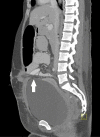Early Onset Outlet Obstruction of a Temporary Diverting Loop Ileostomy Secondary to Urinary Retention
- PMID: 36843658
- PMCID: PMC9947664
- DOI: 10.1159/000529481
Early Onset Outlet Obstruction of a Temporary Diverting Loop Ileostomy Secondary to Urinary Retention
Abstract
A mechanical obstruction is not a physiological entity, and when it occurs within the 30-day postoperative period, it is called an early postoperative small bowel obstruction. Kinking of small bowel segments at the ileostomy outlet secondary to a distended bladder is an unusual source of early postoperative small bowel obstruction. A 36-year-old female underwent a redo J-Pouch surgery and creation of loop ileostomy after pouch failure related to recurrent small bowel obstruction and perianal fistulae. Her foley catheter was removed on postoperative day 3 and she passed a trial of void test. On postoperative day 6, the abdomen became progressively more distended. Computerized tomography (CT) imaging with IV contrast showed small bowel distension extending to the midline anterior to the urinary bladder where it demonstrated a narrowed lumen. These findings were thought to be the cause of small bowel obstruction at this level before the ileostomy. Immediately after CT, a foley catheter was applied with which 2 L of urine was removed, and consequently, gas and stool were observed in the ostomy soon thereafter. Although rare, urinary retention may cause intestinal obstruction, especially in the presence of a loop ileostomy in close proximity.
Keywords: Bowel obstruction; Diverting loop ileostomy; Fistula; J-pouch; Surgery; Urinary retention.
© 2023 The Author(s). Published by S. Karger AG, Basel.
Conflict of interest statement
The authors have no conflicts of interest to declare.
Figures



Similar articles
-
Safety of the temporary loop ileostomy.Colorectal Dis. 2002 Sep;4(5):361-364. doi: 10.1046/j.1463-1318.2002.00398.x. Colorectal Dis. 2002. PMID: 12780582
-
Acute abdomen due to J-pouch outlet obstruction: A case report and review of literature.Int J Surg Case Rep. 2021 Jul;84:106075. doi: 10.1016/j.ijscr.2021.106075. Epub 2021 Jun 15. Int J Surg Case Rep. 2021. PMID: 34147935 Free PMC article.
-
Outlet Obstruction of Temporary Loop Diverting Ileostomy.Hepatogastroenterology. 2015 May;62(139):602-5. Hepatogastroenterology. 2015. PMID: 26897937
-
Palliative Chemotherapy: Does It Only Provide False Hope? The Role of Palliative Care in a Young Patient With Newly Diagnosed Metastatic Adenocarcinoma.J Adv Pract Oncol. 2017 May-Jun;8(4):382-386. Epub 2017 May 1. J Adv Pract Oncol. 2017. PMID: 30018843 Free PMC article. Review.
-
Restorative proctocolectomy without diverting ileostomy.Dis Colon Rectum. 1995 Feb;38(2):188-94. doi: 10.1007/BF02052449. Dis Colon Rectum. 1995. PMID: 7851175 Review.
References
-
- Sencan A, Sencan A, Taneli C, Gunsar C, Genc A, Ayhan S, et al. . Early postoperative small bowel obstruction is a different clinical entity than postoperative adynamic ileus. J Dr Behcet Uz Child Hosp. 2011 Aug;1(2):79–83. 10.5222/buchd.2011.079. - DOI
Publication types
LinkOut - more resources
Full Text Sources

